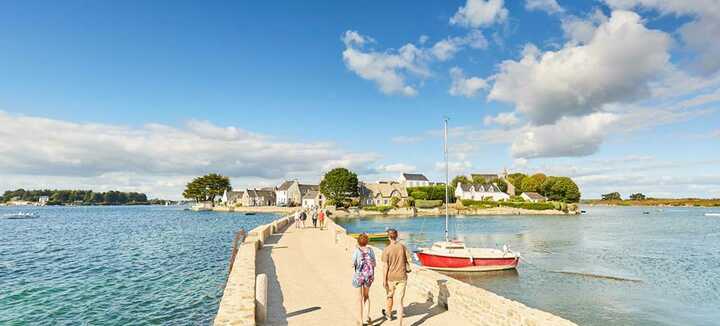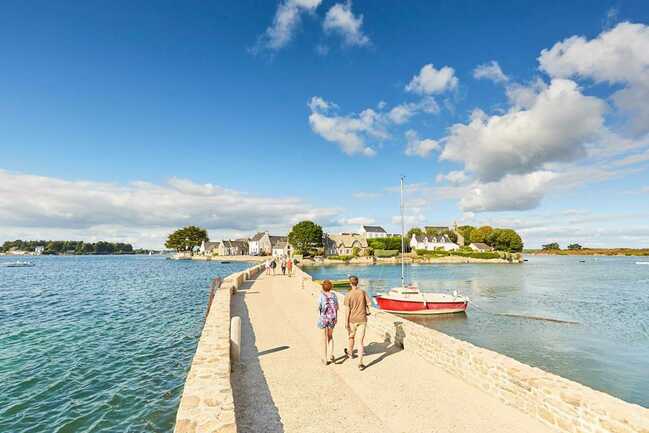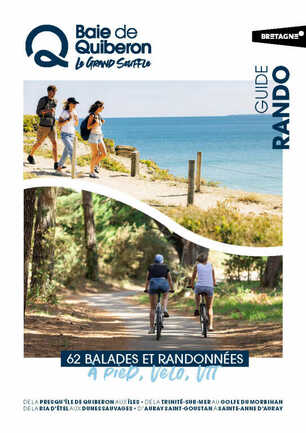
Belz - Etré Douar ha Mor tour (between land and sea)
Parking du stade
56550 Belz
56550 Belz
Features of the route
Difficulty
Easy
Length
2h18
Distance
11.3km
Municipality of departure
Belz
Parking du stade
56550 Belz
56550 Belz
Difficulty level: Easy - Yellow markings
All year round - Wet parts in winter Located in the heart of the Ria d'Étel, Belz has a surprisingly rich natural, architectural and megalithic heritage. This tour takes in the famous village of Saint-Cado, the Ria d'Étel and the megaliths.
Departure point: From the stadium parking lot, turn right into rue des sports, then take the small road on the right around the grounds.
Step by step :
1) Turn left into rue du Stade, cross rue de Kerdonnerc'h. Go straight on.
2) Join Crubelz via the footpaths. Continue along the road, then turn left into rue Er Braden. After 100 m, take the footpath on the left to join the Route d'Auray.
3) Cross it (danger, traffic), go towards le Ganquis. Continue for 100 m past the gîtes, then turn left onto Kervilaine. Take the Ninézur road to the right, then the coastal path to the left at Pont Carnac. Continue to Pointe du Perche in Kerhuen. Panoramic view with orientation table. Opportunity to observe numerous birds (coots).
4) Turn right at the end of the beach, rue du Vieux Kerhuen. In the hamlet, stone houses (1,625), sundial and Kerhuen dolmens at the top of the hill on the left. Originally a megalithic site consisting of 2 corridor tombs and a megalithic chest, only the two dolmens are visible today. These Neolithic tombs were enclosed in an earth-and-stone architecture (tumulus), of which only the base is visible today. The dolmens were restored in 1932 by Zacharie Le Rouzic. Like many Neolithic tombs, the monument is located on a high point in the landscape.
5) At the top of rue du Lannion, head down towards rue du Moulin des Oies. Below, on the right, you'll see the Moulin des Oies Dolmen, excavated and restored by Z. Le Rouzic in 1931. Before the stop sign, turn right into rue de la Fontaine. At the bottom, turn right along the coastal path towards Saint-Cado. Walk around the island, which is linked to the mainland by a stone bridge, and admire the blue-shuttered Nichtarguer house built in 1894. In the early 20th century, this was the largest sardine port on the Ria d'Etel. The island is home to an 11th-12th-century Romanesque chapel, a calvary dating from 1832, and merchants' and fishermen's houses.
6) Walk along the quays to rue Pen Perleieu. Orientation table in rue Pen Mané Bras. Turn right on rue de Pont Er Iaul. After 250 m, at the fountain, turn left onto the footpath leading to the Pont Lorois road. Turn left and then right just after the bridge.
7) Follow the sunken path to the Kerlutu Dolmen (Clerment Roh Clour). While lying on the ground, the pillars of the tomb were straightened and masonry was added during its restoration in 1935 to hold the pillars and cover slab in place. After the dolmen, continue along the path to the right as far as the gymnasium. Join Rue des Sports and the parking lot.
Focus: - The Er Mané dolmen is a gallery dolmen. It features two burials. The buildings are located on the heights of the village, in the same topographical position as all the corridor and chamber tombs. The burials, made up of vertical supports and megalithic slabs, form more or less circular chambers. - Dry stone is used as a wall element for the corridor and chamber, and is placed in the interstices of the vertical slabs. The chamber supports appear to have been surmounted by a low wall to support and stabilize the megalithic roof. The covering slabs have all but disappeared at Er Mané. To the rear, the Er Bernis dolmen has retained only its vertical walls. - The island of Saint Cado is linked to the mainland by a stone bridge, from which you can admire the house built in 1894. In the early 20th century, this was the largest sardine port on the Ria d'Etel. Today, it is home to a 12th-century chapel and fishermen's cottages.
All year round - Wet parts in winter Located in the heart of the Ria d'Étel, Belz has a surprisingly rich natural, architectural and megalithic heritage. This tour takes in the famous village of Saint-Cado, the Ria d'Étel and the megaliths.
Departure point: From the stadium parking lot, turn right into rue des sports, then take the small road on the right around the grounds.
Step by step :
1) Turn left into rue du Stade, cross rue de Kerdonnerc'h. Go straight on.
2) Join Crubelz via the footpaths. Continue along the road, then turn left into rue Er Braden. After 100 m, take the footpath on the left to join the Route d'Auray.
3) Cross it (danger, traffic), go towards le Ganquis. Continue for 100 m past the gîtes, then turn left onto Kervilaine. Take the Ninézur road to the right, then the coastal path to the left at Pont Carnac. Continue to Pointe du Perche in Kerhuen. Panoramic view with orientation table. Opportunity to observe numerous birds (coots).
4) Turn right at the end of the beach, rue du Vieux Kerhuen. In the hamlet, stone houses (1,625), sundial and Kerhuen dolmens at the top of the hill on the left. Originally a megalithic site consisting of 2 corridor tombs and a megalithic chest, only the two dolmens are visible today. These Neolithic tombs were enclosed in an earth-and-stone architecture (tumulus), of which only the base is visible today. The dolmens were restored in 1932 by Zacharie Le Rouzic. Like many Neolithic tombs, the monument is located on a high point in the landscape.
5) At the top of rue du Lannion, head down towards rue du Moulin des Oies. Below, on the right, you'll see the Moulin des Oies Dolmen, excavated and restored by Z. Le Rouzic in 1931. Before the stop sign, turn right into rue de la Fontaine. At the bottom, turn right along the coastal path towards Saint-Cado. Walk around the island, which is linked to the mainland by a stone bridge, and admire the blue-shuttered Nichtarguer house built in 1894. In the early 20th century, this was the largest sardine port on the Ria d'Etel. The island is home to an 11th-12th-century Romanesque chapel, a calvary dating from 1832, and merchants' and fishermen's houses.
6) Walk along the quays to rue Pen Perleieu. Orientation table in rue Pen Mané Bras. Turn right on rue de Pont Er Iaul. After 250 m, at the fountain, turn left onto the footpath leading to the Pont Lorois road. Turn left and then right just after the bridge.
7) Follow the sunken path to the Kerlutu Dolmen (Clerment Roh Clour). While lying on the ground, the pillars of the tomb were straightened and masonry was added during its restoration in 1935 to hold the pillars and cover slab in place. After the dolmen, continue along the path to the right as far as the gymnasium. Join Rue des Sports and the parking lot.
Focus: - The Er Mané dolmen is a gallery dolmen. It features two burials. The buildings are located on the heights of the village, in the same topographical position as all the corridor and chamber tombs. The burials, made up of vertical supports and megalithic slabs, form more or less circular chambers. - Dry stone is used as a wall element for the corridor and chamber, and is placed in the interstices of the vertical slabs. The chamber supports appear to have been surmounted by a low wall to support and stabilize the megalithic roof. The covering slabs have all but disappeared at Er Mané. To the rear, the Er Bernis dolmen has retained only its vertical walls. - The island of Saint Cado is linked to the mainland by a stone bridge, from which you can admire the house built in 1894. In the early 20th century, this was the largest sardine port on the Ria d'Etel. Today, it is home to a 12th-century chapel and fishermen's cottages.


